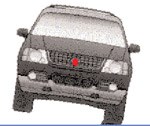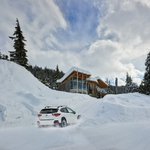Tire Safety
 WARNING!
WARNING!
Tires must never be operated in excess of their rated speed limit!
Exceeding the tire’s speed capability will cause overheating of the tire and sudden tire failure, possibly leading to loss of vehicle control. All Toyo passenger and light truck tires have a maximum speed rating depending on size and type. Consult your tire dealer or contact Toyo at 877-682-8696 if you are not sure about the maximum speed rating of your tires. Toyo Tire Canada Inc. does not endorse the operation of any vehicle in an unsafe or unlawful manner. Obey all local speed limits. Tire speed ratings do not imply that a vehicle can be safely driven at the speed for which the tire is rated. Speed ratings are based on laboratory tests that relate to performance on the road, but are not applicable if tires are underinflated, overloaded, worn out, damaged, or altered.
 WARNING!
WARNING!
Use and Installation of Winter (snow) Tires
Winter driving presents special challenges for vehicle handling. The use of winter tires, studs, and/or chains, while improving snow traction performance, requires additional caution with regard to braking, cornering, and speed. The use of snow tires may reduce the vehicle’s handling and braking capability. It is important to drive with care, not only on snow and ice, but on dry and wet roads as well. Toyo recommends that snow tires be installed in matched, sets of four. This also applies for studded winter tires. When snow tires of a lower speed rating compared to the original tires are installed, the vehicle’s speed capability is reduced. Follow all recommendations in the vehicle owner’s manual regarding the use of winter tires. Consult your tire dealer for more information regarding seasonal restrictions for stud usage.
 WARNING!
WARNING!
Proper Selection of Replacement Tires
Replacement tires for any vehicle must be of a size, load range, and load capacity (by inflation) that are capable of supporting the load of the vehicle’s originally installed (O.E.) tires. Failure to install tires with adequate load capacity will result in tire fatigue and sudden tire failure leading to possible loss of control or an accident.
IMPORTANT! Refer to the vehicle owner’s manual for any specific safety advice regarding the application of replacement tires.
 WARNING!
WARNING!
Tire and Rim Matching
NEVER MOUNT 16” RIM DIAMETER TIRES ON A 16.5” DIAMETER RIM! Any attempt to mount a 16” rim diameter tire on a 16.5” rim diameter will result in an explosion of the tire/rim assembly that can cause severe personal injury or death.
Prior to mounting any 16” rim diameter tires, always check the rim/wheel identification stamp to verify the correct rim diameter. Always check the tire size molded onto the sidewall. NEVER exceed 40 psi when seating the beads on rims.
Warning for additional sizes:
To avoid an explosion of the tire/rim assembly and personal injury or death:
- Never attempt to mount 22” rim diameter tires on any 22.5” diameter rim!
- Never attempt to mount 24” rim diameter tires on any 24.5” diameter rim!
 WARNING!
WARNING!
Replacement Tires for Light Trucks – P-metric vs. LT-metric
Tire installers should exercise extreme caution when replacing tires on light trucks. LT type tires (e.g. LT265/75R16) may not offer adequate load capacity when replacing P-metric type tires (e.g. P265/75R16), depending on the vehicle’s load requirements and the tire’s load/ply rating. LT type tires require much higher air pressures to carry equivalent loads of P-metric tires.
If P-metric type tires are used to replace LT-metric tires, installers should verify the load requirement of the vehicle by checking the tire information placard. Always make sure that replacement tires offer equal or more load capacity (by inflation) compared to the originally installed tires.
If P-metric, or metric tires are intended to replace originally installed LT type tires, the load capacity of the P-metric tire is reduced by 9% at any inflation value. Consult manufacturer’s load and inflation charts. Contact Toyo Consumer Relation with any tire replacement questions: 877-682-8696 (Pacific Time).
Consumer Safety Advisory for Lifted Light Trucks
Rollover Propensity of Lifted Light Trucks
 WARNING!
WARNING!
Consumers should be aware that the installation of larger diameter tires, including off-road type tires, combined with modified suspensions (lift kits) for increased off-road ground clearance will adversely affect the handling and maneuverability characteristics of the vehicle compared to the factory-equipped (original) vehicle.
When vehicles, especially light trucks, are lifted, the center of gravity is heightened, thus making them more prone to rollover. Rollover propensity is further increased with full passenger and/or cargo loads. Other aspects of handling and maneuverability may also be affected by altering the original manufacturer’s design.
 As with any vehicle, extreme care must be used to prevent loss of control or rollover during sharp turns or abrupt maneuvers.
As with any vehicle, extreme care must be used to prevent loss of control or rollover during sharp turns or abrupt maneuvers.
Always wear seat belts and drive safely, recognizing that reduced speeds and special driving techniques may be required.
The installation of larger tire and wheel combinations will reduce the effectiveness of anti-lock braking systems and increase stopping distance.
Failure to safely drive any vehicle equipped with a lift kit may result in an accident resulting in serious injury or death.
Do not drive a lifted vehicle unless you are familiar with its unique handling characteristics and are confident of your ability to maintain control under all driving conditions. Some modifications (and combinations of modifications) are not recommended and may not be permitted in your state.
Consult your owner’s manual, the instructions accompanying the lift kit, and state laws before undertaking any vehicle suspension modifications.
You are responsible for the legality and safety of the vehicle you modify using lift kit and tire modifications.




